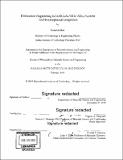Dislocation engineering in InAlGaAs/SiGe alloy systems for heteroepitaxial integration
Author(s)
Shah, Rushabh(Rushabh Dinesh)
Download1098033883-MIT.pdf (14.19Mb)
Other Contributors
Massachusetts Institute of Technology. Department of Materials Science and Engineering.
Advisor
Eugene A. Fitzgerald.
Terms of use
Metadata
Show full item recordAbstract
Semiconductor devices based on GaAs substrates use III-V alloy systems like Inx(AlyGa₁₋y)₁₋xAs for optoelectronic devices and high frequency communication applications. Heteroepitaxial integration of such devices with Si has generated a lot of interest because it has the potential of combining the desired material properties with the low cost of the Si manufacturing platform and enabling monolithic integration with Si CMOS, creating novel integrated circuits. However, heteroepitaxial integration introduces challenges related to detrimental crystal defects like dislocations that are created in the process and require buffer layers to accommodate such defects and minimize their impact on device performance. One buffer layer scheme that is receiving widespread adoption involves the direct growth of Ge on Si. It produces a threading dislocation density ~2x10⁷ cm⁻² but this density is too high for applications like high efficiency GaAs solar cells. In this work, we aim to study two methods that can reduce this defect density. One involves developing a similar procedure to Ge on Si growth, for growing Ge on Si₅₀Ge₅₀. We find that despite the lower lattice mismatch and availability of pre-existing mobile dislocations in this approach, the Ge film retains a high metastable strain that generates a high density of crystal defects. The second method involves the use of low x Inx(A1yGa₁₋y)₁₋xAs buffer layers that use compressive strain to encourage dislocation reactions and drive dislocations to sinks (mesa sidewalls). Filtering effects lead to a reduced threading dislocation density, the lowest measured in this study is 7x10⁶cm⁻² , but these effects do not scale with x, showing that dislocation sources are active and play an important role. These films have residual tension due to differences in coefficient of thermal expansion with Si substrates. Recombination enhanced dislocation glide effects permit direct visualization of processes that operate to relive this residual strain at room temperature, in cathodoluminescence imagining conditions. This provides a first estimate of density of dislocation sources and interaction probability between dislocations under residual strain conditions. Unexpected dark line defects were observed in cathodoluminescence imaging and the use of "overshoot layer" was demonstrated to be critical in reducing their density. Preliminary work towards processing photovoltaic cells and a layer transfer method that involves wafer bonding for reuse of buffer layers is also discussed.
Description
Thesis: Ph. D., Massachusetts Institute of Technology, Department of Materials Science and Engineering, 2019 Cataloged from PDF version of thesis. Includes bibliographical references (pages 87-92).
Date issued
2019Department
Massachusetts Institute of Technology. Department of Materials Science and EngineeringPublisher
Massachusetts Institute of Technology
Keywords
Materials Science and Engineering.